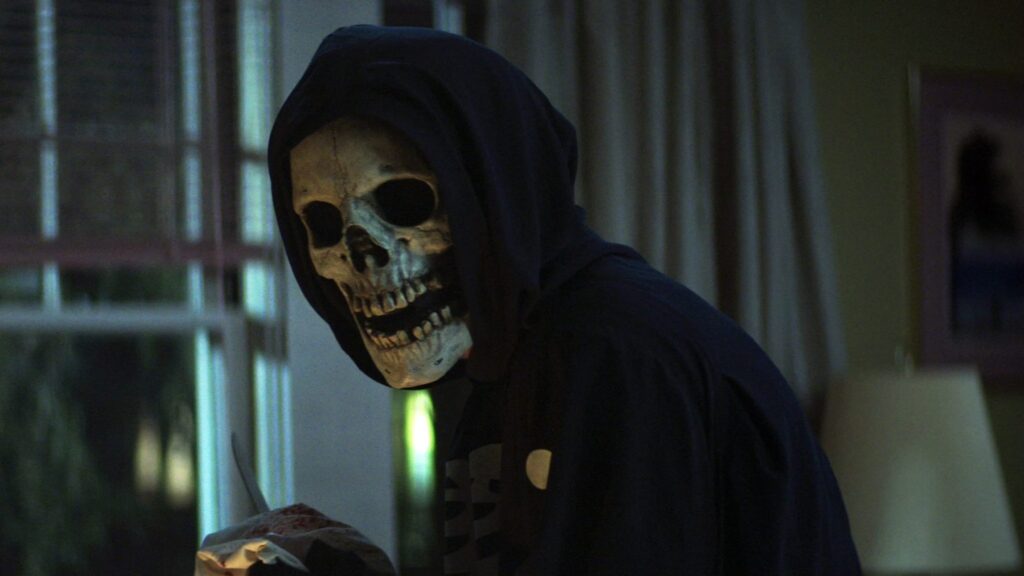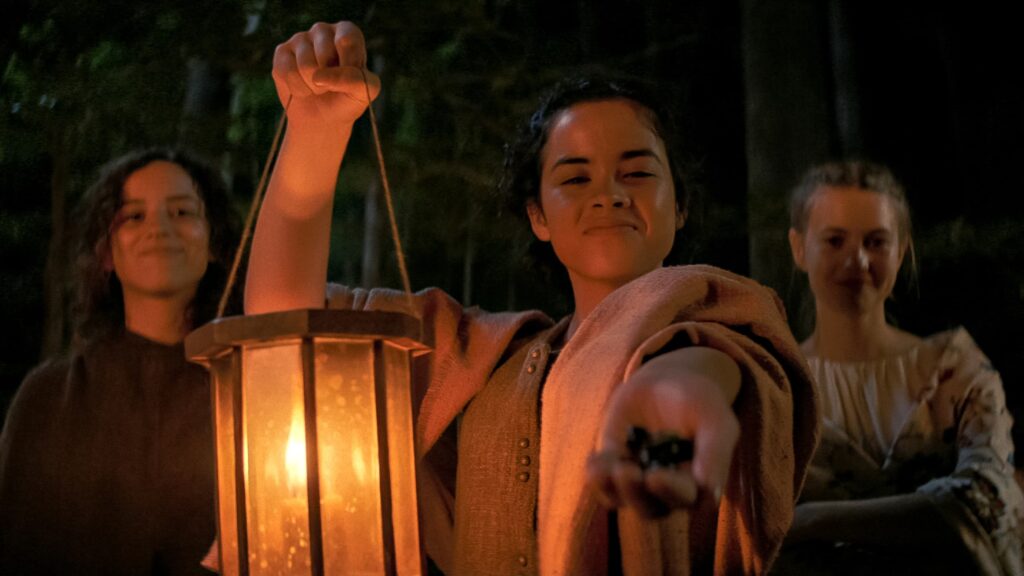Based on the series of books by R.L. Stine, Fear Street is a trilogy set in three distinct time periods. As near as I can tell, these movies are not specific adaptations of particular books in Stine’s long-running series, but they do keep the pattern of generally focusing on older teens and thus more gruesome stories than Stine’s more famous Goosebumps series. Like our last 6WH entry on television series, this is a trilogy that seemingly blurs the line between mediums. Is it three movies, or one 4-6 episode series (depending on how you break things up)? Does it matter? Let’s take a closer look:
The Six Weeks of Halloween: Week 4 – Fear Street
- Scream (trailer)
- How Scream Should Have Ended (short)
- It’s the Gifts That I Hate (Robot Chicken)
Fear Street: 1994 – A killer shows up in a town famous for killers showing up, supposedly due to the curse of local witch Sarah Fier. It’s like finding a dusty box filled with old Tor horror paperbacks, 90s pop music CD collections, some Stephen King, and VHS copies of Scream and Blair Witch. This sort of nostalgic kitsch might not appeal to everyone, but while its influences are clear, it remixes them with enough vigor to keep things interesting.
There are some well constructed twists and turns and the actions our heroes take are generally logical. There was only one I’m going to walk off alone now even though there’s a killer out there moment, and even that works out well enough. The way they figure out how the curse is working and leverage that to their advantage is clever, as is the ultimate (er, penultimate, I guess) conclusion.
Writer and director Leigh Janiak made the whole trilogy and she ensured that it was thematically of the moment. You can read a lot into the movie, but it isn’t super preachy about it (they lean on some things heavily at times, but it’s not pedantic about it). Our heroes are doomed outsiders, there’s the blessed rich town next to the cursed poor town, a healthy distrust of authority, and the old standby of cyclical violence that pervades the entire series.
While it’s certainly competently made, it does look a little flat. Call it the Netflix programmer house style. I’m not a photography expert or anything, but something about this just lacks distinction. They try to make up for it by darkening everything (a technique that gets progressively worse throughout the series – it’s not that bad here), but that just makes some scenes hard to see. Also, while I can appreciate the soundtrack’s nostalgic appeal (it’s the soundtrack to my teen years, so it was a bit of a trip), the needle drops are excessive. Just a very high density of needle drops, sometimes one leading right into another without any break. It’s a bit of a crutch and can get distracting at times.
So I have some complaints, but it’s ultimately a good time and I really enjoyed it. While it has that thing where movies can’t just end anymore, I knew that going in and as hinted at above, this really does feel like it’s straddling that line between movie and tv show. What I did know was that I did want to watch the next movie, which is not always the case when a movie ends with a blatant setup for the next movie. ***
- Thursday the 12th (Robot Chicken)
- Thanksgiving (fake trailer)
- Halloween RARE Deleted Scene 1978 (short)
Fear Street: 1978 – This prequel is framed by segments still set in 1994 where a character recounts her tragic involvement in the 1978 Camp Nightwing massacre. It’s one of those killers, inspired by witchery, that the town is famous for, and we actually saw him in the first film… which represents the real problem here.
It’s the typical prequel problem: how do you tell a story set in the past without repeating yourself or completely telegraphing the ending because you know where certain characters will be in the original/sequel/whatever. There are ways to do it, but this movie can’t quite manage it. You start off knowing that two figures who are consistently put in danger throughout the movie are going to survive (one of them is telling us the story in the first place). And you know that one character you care about is going to die going into it. It’s also the middle film of a trilogy, which has its own constraints.
Which is a shame, because as I’ve amply demonstrated during these Six Weeks of Halloween marathons, I genuinely enjoy a good slasher movie. This is ostensibly playing Friday the 13th to 1994’s Scream, but it winds up just feeling repetitive, right down to the overuse of needle drops. Again, it’s competently made but a little flat, and the technique of turning down the brightness gets more noticeable here. One thing I should mention that stuck out to me as a good thing is the production design, especially of the witchy stuff (but they also capture the camp vibe pretty well). There are a few chunks of witch lore that are revealed that are important to the overarching story, but that’s not quite enough to sustain the full runtime, which is a tad long for a slasher.
I’m coming down hard on this movie, but it’s not unwatchable or anything. It’s just repetitive and as a prequel, we already know a fair amount of this stuff. It’s repetitive, is what I’m saying. I had a fine time watching it, I guess, but have I mentioned that it’s repetitive? Right. **
- How the Blair Witch Project Should Have Ended (short)
- The Witch (trailer)
- The Simpsons: Treehouse of Horror VIII: Easy-Bake Coven (Disney+)
Fear Street: 1666 – And now we flash back even further, to the origins of the witch Sarah Fier’s curse. Here we mix up subgenres a bit, heading more towards gothic witchcraft than self-aware slasher. It’s a classic tale of blights followed by a witch hunt pursued with righteous fervor by a mob of townfolk, literally carrying pitchforks and torches. But all is not what it seems!
There’s a nice twist revealed in the first half of this movie, at which point the action returns to 1994, where our heroes must reckon with what they’ve learned. In a big showdown at the mall, they put the curse to rest. Spoilers, I guess, but that seems pretty obvious. The 1994: Part 2 section shows the characters relying on similar tactics to the first movie, though they put some clever twists on it. It reminds me of the way science fiction takes some seemingly innocuous rules, then spins out implication after implication that can be leveraged by clever characters to achieve various aims. Alas, these moments are mostly glossed over because the real action is happening elsewhere.
Both segments of this movie feature that same flat visual affect. The 1666 portion, in particular, is excessively dark. I guess the idea here is to rely on more natural lighting due to the setting. It’s a good instinct! Stanley Kubrick and John Alcott used that approach on Barry Lyndon, but they had these insane cameras and lenses that were great at photographing low light subjects. Alas, the 1666 segment just comes off muddy and overly dark (not sure if that’s a digital after-effect, or a limitation of the equipment used, or maybe both). Ok, it’s probably not fair to compare something like this to Kubrick, but still. The 1994 segment opts for a neon glow-in-the-dark aesthetic that’s certainly different. The production design remains great.
After the first two movies, the 1666 part of this movie is blessedly free from needle-drops, relying on a more traditional music score. Of course, the hits of the 90s return in full force in the second segment of the movie. I’m being hard on this aspect of the movies, but maybe I just got used to it by the end, because it wasn’t that awful this time around.
It’s a fine ending and continues the themes established throughout the series. It’s not as repetitive as the 1978 movie, and it ties together a lot of what we’ve seen, often subverting some aspects of the genre, which was a nice touch. It’s a fun series, and the stinger at the end of this indicates we’ll probably see more Fear Street stories on Netflix at some point. While I have my complaints, the movies were a lot of fun and I look forward to future entries in the series. **1/2
Overall an above average Netflix programmer, well worth checking out even though I whined about a bunch of stuff above. Not sure what we’ll do next, but stay tuned. Two more weeks of Halloween to go, followed by the big day and traditional Speed round…



I enjoyed it, but I feel like I need to rewatch them again to appreciate it all. Was such hype when they came out, I feel like I rushed.
I remember when they came out, and the conversation on social media definitely lasted longer than your usual Netflix offering because they spread the series out for a few weeks… But then I don’t think I remember anyone talking about it after the fact. It’s that weird streaming hype that almost immediately disappears when the next thing is released…